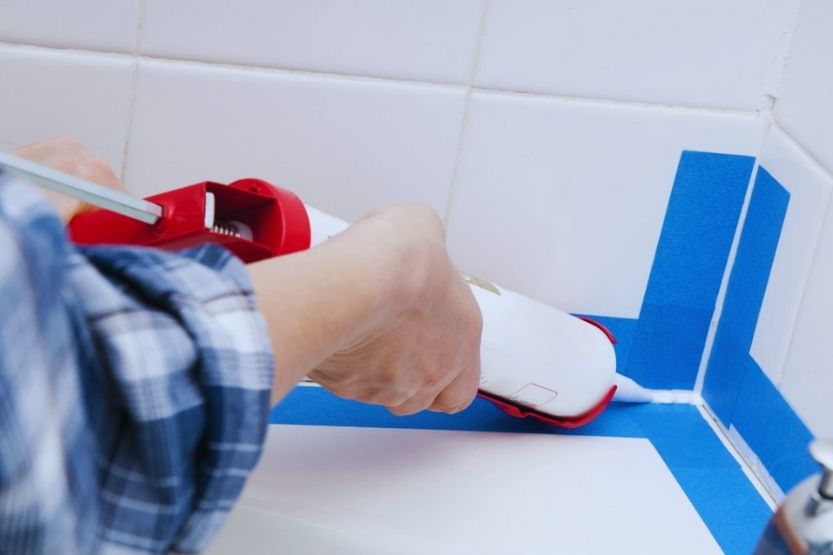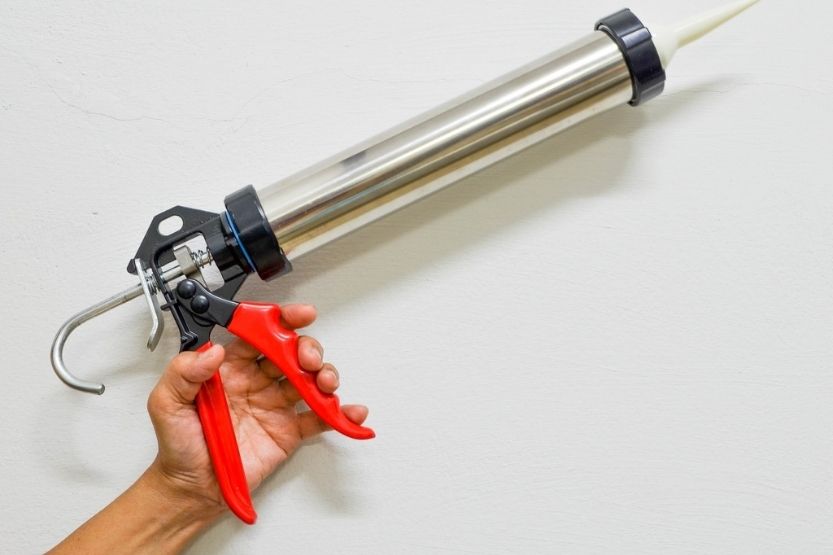Silicone caulk is ideal for sealing plumbing fixtures such as sinks, bathtubs, toilets, and showers. It is also great for weatherproofing the house. But it can be challenging to apply it evenly and smoothly to achieve a flawless finish. Can you smooth silicone caulk with Windex?
You can smooth silicone caulk with Windex. Apply enough silicone caulk to the joint and then spray it with Windex. Then, use a tool such as a scraper to remove excess caulk. The Windex does not stick to the silicone, and you will be able to smooth it evenly.
Read on to learn more about how to smooth silicone caulk using Windex or other similar formulas.
Smooth Silicone Caulk with Windex

You can smooth silicone caulk with Windex by applying enough silicone caulk to the joint and spraying it with Windex. Then, use a scraper or a similar tool that can help you remove excess caulk. You will be able to smooth it evenly since Windex does not stick to the silicone.
Let’s first talk about silicone caulk and Windex separately before explaining Windex’s impact on smoothing silicone caulk.
What Is Silicone Caulk
Silicone caulk is an adhesive sealant that you can use for many household and professional applications. It is highly resistant to the following:
- Chemicals,
- Water,
- Temperature, and
- Weather.
Thus, it is a versatile product for indoor and outdoor use.
Most silicone caulk products have a gel-like consistency. It does not have a glue-like texture which you can find in polymer-based adhesives. Silicone caulks are often used in construction and repairs.
Allow the silicone caulk to properly cure so that it can fully act as a sealant. This will normally take around 24 hours. But if you apply heavier coats, curing time may last for a few more days.
What Is Windex
Windex is a foaming glass cleaner brand that impressively delivers streak-free shine. But aside from glass cleaning, it is surprisingly useful for other applications. These include the following:
- Stain Remover
- Dry Erase Board Cleaner
- Clean Patio Furniture
- Clean Toys
- Kill Bugs
- Remove a Tight Ring
- Lift Up Tough Grease
- All Purpose Cleaner
Indeed, Windex is considered an all-purpose cleaner. And smoothing and cleaning excess silicone caulk on your sealing projects is one of the things it does best.
There are many other ways of smoothing silicone caulk. But applying Windex is one of the best methods.
How to Smooth Silicone Caulk

Silicone caulk is very sticky, making it challenging to apply it smoothly and evenly. But there are several methods you can try to ensure that you will achieve a flawless finish.
Our tips on how to smooth silicone caulk are the following:
- Use Masking Tape
- Smooth Using Your Finger or a Tool
- Apply It Fast
- Use a Damp Rag
- Work in Sections
1. Use Masking Tape
The masking tape plays a big role in keeping your projects clean and tidy. All you have to do is place strips of masking tape on areas where you don’t want the sealant to touch. Just leave enough space where you will apply the caulk.
For instance, if you apply silicone caulk between several tiles, you have to put one long strip of masking tape above and below the space where you will apply the sealant. Make sure that you stick the masking tape evenly in a straight line. That way, the sealant will all be neat when you strip it off.
2. Smooth Using Your Finger or a Tool
After applying the silicone caulk, you can easily smooth it using your finger. All you have to do is to run your finger on the line of caulk that you applied. Make sure to apply even pressure as you run your finger so that you will achieve real smoothness.
You can also smooth silicone caulk with Windex. Instead of using your bare finger, you can use a rag to smooth the caulk right after applying Windex. You can also use a tool like a scraper instead of a rag.
3. Apply It Fast
Make sure to smooth the applied silicone caulk fast before it starts to dry. Once it starts drying, it will be difficult to smooth it evenly.
This is the reason why many people use Windex for the smoothing process. It makes it easier for them to run the rag or the tool along the surface.
4. Use a Damp Rag
In case you find small ridges left after smoothing the silicone caulk, you can use a damp rag to remove them. That way, you can ensure that you will achieve an even finish.
This is also why some people use a tool like a scraper to smoothen the silicone caulk. It prevents ridges from appearing.
5. Work in Sections
If you are working on a big sealing project, don’t apply silicone caulk on all surfaces at once. Instead, it is better to work in small sections. Remember that the caulk dries a little fast. If you apply it all at once, it might be impossible to smooth all surfaces evenly.
You might think that it will take you a long time to finish your project if you work in sections. Maybe, it’s true. But it will give you better results too.
Again, how to smooth silicone caulk with Windex? To smooth the caulking line with Windex, start with applying the caulk, then wet the area with Windex. Smooth out the area with your finger or a chosen device.
How to Smooth Silicone Caulk – Wet Finger Technique Vs Tool Technique
Many people use the wet finger technique. But this is because they don’t have any other tool available. Using this technique, they wet their finger first with water and then apply soap before smoothing the surfaces.
The downside of this is that it leaves the finger messy. If you don’t clean your finger thoroughly, it will be impossible to smooth the rest of the surfaces using your finger evenly. In other words, you might not get the professional look that you want to achieve. This is particularly true for big projects.
That’s why using a tool like a scraper is more advisable. It is easier to run it down the surfaces, and it is easier to wipe off caulks that stick to the scraper.
So, when you go out to buy silicone caulk for your sealing project, make sure to buy a scraper too. Anyway, it is most likely always available in hardware stores.
How to Seal Surfaces – Silicone Caulk Vs Latex Caulk

Aside from silicone caulk, you can also use latex caulk for your projects. Let’s take a look at their similarities and differences by discussing their advantages and disadvantages:
Advantages of Latex Caulk
Latex caulk also addresses plumbing issues such as loose tiles and leaking sinks, toilets, showers, and bathtubs. It can also seal crown molding and baseboards.
Like silicone caulk, the latex caulk is used to fill in gaps or unwanted spaces. It can effectively seal and caulk windows and frames. Also, it can handle porous materials like wood, plaster, drywall, or masonry. Latex caulk can resist water seepage.
Latex caulk is available in different colors, but it is also paintable. That’s why many people also use this for decorative purposes, as it also looks appealing.
This type of caulk dries faster. So, if you want to finish your project as soon as possible, this can be a suitable product for you.
Disadvantages of Latex Caulk
The problem with latex caulk is that it can’t withstand extreme weather conditions or temperatures. It is also a little costly.
Summary of Pros and Cons of Using Latex Caulk
| Pros | Cons |
| Ideal for indoor use and applications | Cannot withstand extreme weather conditions or temperatures |
| Maybe paintable for decorative purposes or added appeal | A little costly |
| It gives rise to durable seals in indoor and outdoor environments. | |
| Adheres tightly to most common building materials | |
| It lasts up to 20 years on average. |
Advantages of Silicone Caulk
Whatever issues you encounter when using latex caulk, you can address this when you instead use silicone caulk.
Here are the advantages of using silicone caulk:
- Seal Cracks in Plastic and Metal
- Fill in Cracks on Doors or Windows
- Handle Plumbing Mechanisms
- Can Be Used for Impromptu Repairs
- Ideal for Non-porous Surfaces
1. Seal Cracks in Plastic and Metal
Latex caulk is not capable of handling plastic and metal, but silicone caulk is. Suffice to say that silicone caulk is more flexible and versatile compared to latex caulk.
2. Fill in Cracks on Doors or Windows
If your windows or doors have cracks, filling them with silicone caulk is a great idea. Silicone caulk can indeed help you maintain your house in its perfect condition.
3. Handle Plumbing Mechanisms
Silicone caulk can also handle plumbing mechanisms, whether at home or work. Using this type of caulk to fill in gaps on bathtubs, sinks, or showers is easy. It effectively minimizes, if not eliminates, water seepage.
4. Can Be Used for Impromptu Repairs
It’s easy to find silicone caulk in hardware stores. It is always available, unlike the latex caulk. This is the reason why it is often used for emergency repairs.
5. Ideal for Non-porous Surfaces
Silicone caulk has a tight-sealing nature, making it ideal even for non-porous surfaces.
Summary of Pros and Cons of Using Silicone Caulk
| Pros | Cons |
| Cheaper than other sealants | It can only last for a shorter duration of time |
| Rarely breaks or cracks even under intense impacts | Exudes some offensive odor |
| Can withstand extreme weather conditions or temperatures | It can be challenging to apply on surfaces |
| It helps to prevent water damages | |
| Always readily available in stores |
Conclusion – Smooth Silicone Caulk with Windex
You can effectively smooth silicone caulk with Windex by applying enough amount in the joint and spraying it with Windex. Then, use a scraper or a similar tool that can help you remove ridges or excess caulk. You will be able to smooth it evenly since Windex does not stick to the silicone.
Related reading:
Is Duct Tape Conductive? Is Electrical Tape Conductive?
How to Run Ethernet Cable Through Walls



